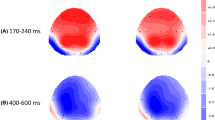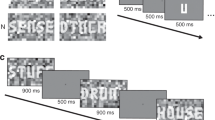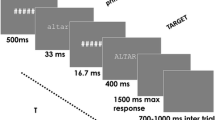Abstract
We investigated the necessary role of the right parietal lobe in visual word recognition using transcranial magnetic stimulation (TMS). TMS was applied to the right posterior parietal lobe and to a control area as participants read aloud words presented either in lower case or in mIxEd-cAsE. The words were presented either with unlimited duration and high contrast (Experiment 1), or with brief presentation and low-contrast (Experiments 2 and 3). In all three experiments, TMS over the parietal area disrupted reading, and in Experiments 2 and 3 this effect was most pronounced for mIxEd-cAsE words. This suggests that the right parietal lobe mediates the recognition of words in unfamiliar formats.




Similar content being viewed by others
References
Baylis GC, Driver J, Baylis LL, Rafal RD (1994) Reading of letters and words in a patient with Balint’s syndrome. Neuropsychologia 32:1273–1286
Besner D, Johnston JC (1989) Reading the mental lexicon: on the uptake of visual information. In: Marslen-Wilson W (ed) Lexical representation and process. MIT, Cambridge MA, pp 291–316
Besner D, Stolz JA (1999) What kind of attention modulates the Stroop effect?. Psychon Bull Rev 6:99–104
Caramazza A, Hillis AE (1990) Levels of representation, co-ordinate frames, and unilateral neglect. Cogn Neuropsychol 7:391–445
Cooper AC, Humphreys GW, Hulleman J, Praamstra P, Georgeson M (2004) Transcranial magnetic stimulation to right parietal cortex modifies the attentional blink. Exp Brain Res 155:24–29
Corbetta M, Kincade JM, Shulman GL (2002) Neural systems for visual orienting and their relationships to spatial working memory. J Cogn Neurosci 14:508–523
Evett LJ, Humphreys GW (1981) The use of abstract graphemic information in lexical access. Q J Exp Psychol 33:225–250
Ferrand L, New B (2003) Syllabic length effects in visual word recognition and naming. Acta Psychol 113:167–183
Flitman SS, Grafman J, Wasserman EM, Cooper BA, Pascual-Leone A, Hallet M (1998) Linguistic processing during repetitive transcranial magnetic stimulation. Neurology 50:175–181
Forster KI, Davis C (1984) Repetition priming and frequency attenuation in lexical access. J Exp Psychol Learn Mem Cogn 10:680–698
Frederiksen JR, Kroll JF (1976) Spelling and sound: approaches to the internal lexicon. J Exp Psychol Hum Percept Perform 2:361–379
Friedman-Hill SR, Robertson LC, Treisman A (1995) Parietal contributions to visual feature binding—evidence from a patient with bilateral lesions. Science 269:853–855
Hall DA, Humphreys GW, Cooper ACG (2001) Neuropsychological evidence for case-specific reading: multi-letter units in visual word recognition. Q J Exp Psychol 54:439–467
Heinke D, Humphreys GW (2003) Attention, spatial representation, and visual neglect: simulating emergent attention and spatial memory in the selective attention for identification model (SAIM). Psychol Rev 110:29–87
Humphreys GW, Price CJ (1994) Visual feature discrimination in simultanagnosia—a study of 2 cases. Cogn Neuropsychol 11:393–434
Jalinous R (1998) Guide to magnetic stimulation. The MagStim Company, Whitland, Wales
Johnston JC, McClelland JL (1974) Perception of letters in words: seek not and ye shall find. Science 184:1192–1194
Karnath HO, Ferber S, Himmelbach M (2001) Spatial awareness is a function of the temporal not the posterior parietal lobe. Nature 411:950–953
Kassubek J, Schmidtke K, Kimmig H, Lücking CH, Greenlee MW (2001) Changes in cortical activation during mirror reading before and after training: an fMRI study of procedural learning. Cogn Brain Res 10:207–217
Kucera H, Francis WN (1967) Computational analysis of present-day American English. Brown University, Providence, Rhode Island
Laberge D (1983) Spatial extent of attention to letters and words. J Exp Psychol Hum Percept Perform 9:371–379
Lavidor M, Walsh V (2003) Magnetic stimulation studies of foveal representation. Brain Lang 88:331–338
Mari-beffe P, Estevez AF, Danziger S (2000) Stroop interference and negative priming: problems with inferences from null effects. Psychon Bull Rev 7:499–503
Mayall KA, Humphreys GW, Mechelli A, Olson A, Price CJ (2001) The effects of case mixing on word recognition: evidence from a PET study. J Cogn Neurosci 13:844–853
Mort DJ, Malhotra P, Mannan SK, Rorden C, Pambakian A, Kennard C, Husain M (2003) The anatomy of visual neglect. Brain 126:1986–1997
Pascual-Leone A, Gates JR, Dhuna A (1991) Induction of speech arrest and counting errors with rapid-rate transcranial magnetic stimulation. Neurology 41:697–702
Riddoch J, Humphreys GW, Cleton P, Fery P (1990) Interaction of attention and lexical processes in neglect dyslexia. Cogn Neuropsychol 7:479–517
Steinsträter O, Sommer J, Deppe M, Knecht S (2002) The Münster T2T-converter. Available at: http://neurologie.uni-muenster.de/ger/t2tconv/
Stewart L, Walsh V, Frith U, Rothwell JC (2001) TMS produces two types of speech disruption. Neuroimage 13:472–478
Stolz JA, Besner D (1996) Role of set in visual word recognition: activation and activation blocking as nonautomatic processes. J Exp Psychol Hum Percept Perform 22:1166–1177
Stolz JA, Besner D (1998) Levels of representation in visual word recognition: a dissociation between morphological and semantic processing. J Exp Psychol Hum Percept Perform 24:1642–55
Talairach J, Tournoux P (1988) Co-planar stereotaxic atlas of the human brain, Thieme medical, New York
Townsend JT, Ashby FG (1983). Stochastic modelling of elementary psychological processes. Cambridge University, Cambridge
Ungerleider LG, Courtney SM, Haxby JV (1998) A neural system for human visual working memory. Proc Natl Acad Sci 95:883–889
Vallar G (2001) Extrapersonal visual unilateral spatial neglect and its neuroanatomy. Neuroimage 14:52–58
Walsh V, Cowey A (2000) Transcranial magnetic stimulation and cognitive neuroscience. Nat Rev Neurosci 1:73–79
Walsh V, Pascual-Leone A (2003) Transcranial magnetic stimulation: a neurochronometrics of mind. MIT Press, London
Wasserman EM (1998) Risk and safety of repetitive transcranial magnetic stimulation: report and suggested guidelines from the International Workshop on the safety of transcranial magnetic stimulation, June 5–7, 1996. Electroencephal Clin Neurophysiol 107:1–16
Weekes BS (1997) Differential effects of number of letters on word and nonword naming latency. Q J Exp Psychol 50:439–456
Young AW, Newcombe F, Ellis AW (1991) Different impairments contribute to neglect dyslexia. Cogn Neuropsychol 8:177–191
Acknowledgements
This work was supported by grants from the BBSRC and the MRC to G.W.H., and a University of Birmingham studentship to W.B. We would like to thank Peter Praamstra, as well as the reviewers, for constructive comments on earlier versions of this manuscript.
Author information
Authors and Affiliations
Corresponding author
Rights and permissions
About this article
Cite this article
Braet, W., Humphreys, G.W. Case mixing and the right parietal cortex: evidence from rTMS. Exp Brain Res 168, 265–271 (2006). https://doi.org/10.1007/s00221-005-0085-z
Received:
Accepted:
Published:
Issue Date:
DOI: https://doi.org/10.1007/s00221-005-0085-z




